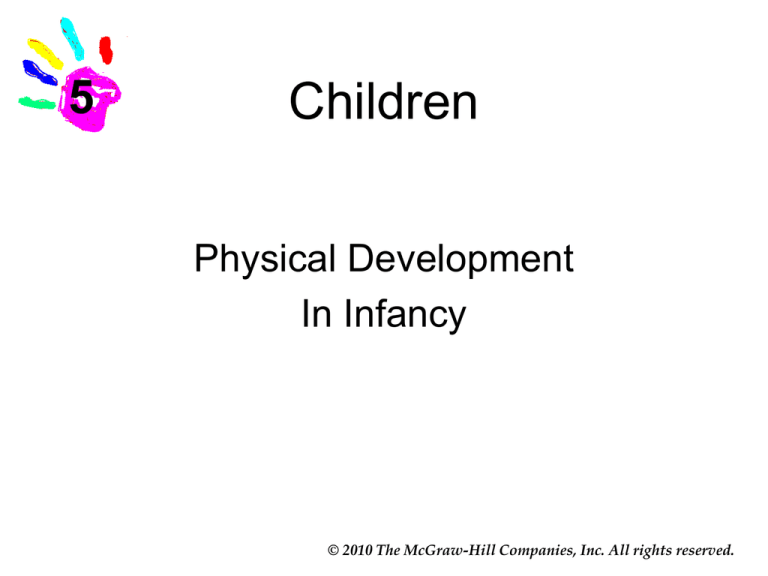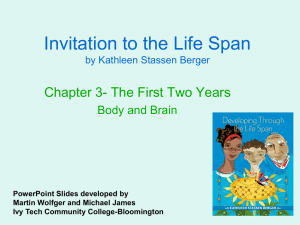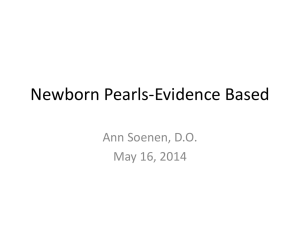
5
Children
Physical Development
In Infancy
© 2010 The McGraw-Hill Companies, Inc. All rights reserved.
How Do Infants Grow and Develop Physically?
Patterns of Growth
• Cephalocaudal: size, weight, and feature
differentiation gradually work from top to
bottom
• Proximodistal: growth starts at center of
body and moves toward extremities
© 2010 The McGraw-Hill Companies, Inc. All rights reserved.
How Do Infants Grow and Develop Physically?
Changes in Proportions of
the Human Body During Growth
© 2010 The McGraw-Hill Companies, Inc. All rights reserved.
How Do Infants Grow and Develop Physically?
Height and Weight
• Average North American newborn is 20
inches and 7½ pounds
– Birth weight doubles by 4 mos; triples at end of
first year; First year growth averages 1 inch per
month
– 1½ times birth length at end of 1st year
• Average 2-year-old
– 26 to 32 pounds and 32 to 35 inches tall
– Growth rate considerably slower in second year
© 2010 The McGraw-Hill Companies, Inc. All rights reserved.
How Do Infants Grow and Develop Physically?
Brain Development
• Extensive growth in utero and infancy
• Shaken baby syndrome: brain swelling
and hemorrhaging
• PET and MRI scans may harm infant
• EEG shows brain activity spurt from 1½ to
2 years of age
© 2010 The McGraw-Hill Companies, Inc. All rights reserved.
How Do Infants Grow and Develop Physically?
The Human Brain’s Hemispheres
© 2010 The McGraw-Hill Companies, Inc. All rights reserved.
How Do Infants Grow and Develop Physically?
The Brain’s Four Lobes
(body sensations)
(voluntary
movement
and thinking)
Prefrontal
cortex
(vision)
(hearing)
© 2010 The McGraw-Hill Companies, Inc. All rights reserved.
How Do Infants Grow and Develop Physically?
Brain Development
• Neuron: info processing nerve cell
– Axons and dendrites
• Myelin sheath: layer of fat cells
– Encases and insulates most axons
– Myelination continues into adolescence
• Synapses: tiny gaps
– Neurotransmitters
© 2010 The McGraw-Hill Companies, Inc. All rights reserved.
How Do Infants Grow and Develop Physically?
The Development of Dendrite Spreading
At birth
1 month
3 months
15 months
24 months
© 2010 The McGraw-Hill Companies, Inc. All rights reserved.
How Do Infants Grow and Develop Physically?
Brain Development
• “Blooming” and “pruning”
• Synaptic overproduction peaks about 4
months after birth
• Prefrontal cortex overproduction peaks
about 1 year of age
– Adult density achieved in adolescence
– Heredity and environment affect timing
© 2010 The McGraw-Hill Companies, Inc. All rights reserved.
How Do Infants Grow and Develop Physically?
Synaptic Density in Human Brain from Infancy to Adulthood
70
60
Synaptic density
50
40
30
20
10
0
100
200
300
400
500
600
800
1000
1500
2000
3000
4000
6000
8000 10,000
Age in©days
(from
conception)
2010 The
McGraw-Hill
Companies, Inc. All rights reserved.
How Do Infants Grow and Develop Physically?
Early Experience and the Brain
• Environmental experiences important
• Infant’s brain waiting for experiences
• Early experiences and enriched environment
• Brain heavier in weight with thicker layers
• Brain develops more neural connections
• Produces higher neurochemical activity
– Impoverished environment
• Depression is common
© 2010 The McGraw-Hill Companies, Inc. All rights reserved.
How Do Infants Grow and Develop Physically?
Sleep
• Newborn
– Sleep varies from 10 to 21 hours each day
– Preferred sleep times and patterns vary
– 20% to 30% have sleep difficulties
• Culture affects sleep patterns
– Length of sleep periods related to sleeping
arrangements and parental activities
© 2010 The McGraw-Hill Companies, Inc. All rights reserved.
How Do Infants Grow and Develop Physically?
Sleep
• Regulation of wake-sleep cycle reflects
neurological maturation; cycles vary
• REM (Rapid Eye Movement) sleep
– Adults—fifth of sleep
– Infants—half of sleep
– May promote brain’s development in infancy
© 2010 The McGraw-Hill Companies, Inc. All rights reserved.
Sleep Across the Human Life Span
24
16
Total daily sleep (hours)
14
12
10
8
6
4
2
0
1-15
days
Newborn
6
mo
12
mo
18
mo
Infants
2
yrs
10
yrs
20
yrs
Children Adolescents
30
yrs
Adults
40
yrs
50
yrs
60
yrs
70
yrs
80
yrs
Older adults
© 2010 The McGraw-Hill Companies, Inc. All rights reserved.
90
yrs
How Do Infants Grow and Develop Physically?
Shared Sleeping
• Culture and Sleeping Arrangements
– Sharing bed common in many cultures
– Crib/separate room common in U.S.
– American Academy of Pediatrics discourages
co-sleeping because of stress and SIDS risk
© 2010 The McGraw-Hill Companies, Inc. All rights reserved.
How Do Infants Grow and Develop Physically?
Sudden Infant Death Syndrome (SIDS)
• Infant stops breathing, usually during
night, and dies without apparent cause
–
–
–
–
Highest cause of infant death in U.S.
Highest risk is 2 to 4 months of age
Prone position reduces risk
Less common in bedroom with fan and infant
who sleeps with pacifier
© 2010 The McGraw-Hill Companies, Inc. All rights reserved.
How Do Infants Grow and Develop Physically?
Sudden Infant Death Syndrome (SIDS)
• Highest risks
–
–
–
–
–
–
–
–
Lower birth weight
Siblings with SIDS
Sleep apnea
Lower SES groups
Exposure to cigarette smoke
Placement in soft bedding
Abnormal brain stem functioning
African American and Inuit infants
© 2010 The McGraw-Hill Companies, Inc. All rights reserved.
How Do Infants Grow and Develop Physically?
Nutrition
• Healthy infants need
–
–
–
–
–
–
–
Loving, supportive feeding environment
50 calories per day per pound of weight
Breast milk (nature’s food)
Gradual increase of chew-and-swallow
More fruits and vegetables, less junk food
Demand feeding becoming more popular
Poor dietary patterns can cause overweight
© 2010 The McGraw-Hill Companies, Inc. All rights reserved.
How Do Infants Grow and Develop Physically?
Breast Versus Bottle Feeding
• Breast milk
–
–
–
–
–
–
–
–
Fewer gastrointestinal infections
Lower respiratory tract infections
Reduces effects of asthma in first 3 months
Reduce risk of skin inflammation
May lessen likelihood of obesity
Lowers risk of childhood and adult diabetes
Less risk of experiencing SIDS
Claims of no link to allergy prevention
© 2010 The McGraw-Hill Companies, Inc. All rights reserved.
How Do Infants Grow and Develop Physically?
Malnutrition in Infancy
• Early weaning can cause deficiencies
• Infants can develop
– Marasmus: wasting away of body tissues in
infant’s first year, severe lack of protein
– Kwashiorkor: deficiency in protein; child’s
abdomen, feet become swollen with water
– If not fatal, effects are detrimental; lowest SES
aided most by supplementary feeding
© 2010 The McGraw-Hill Companies, Inc. All rights reserved.
How Do Infants Grow and Develop Physically?
Health
• Immunization begins in infancy
• Accident prevention
–
–
–
–
–
Increased monitoring needed in infancy
Asphyxiation: leading cause of death under 1
Choking hazards: toys, chunky foods
Burn risks: sun, electrical, heaters, hot water
Other risks: car accidents, cuts, pet bites
© 2010 The McGraw-Hill Companies, Inc. All rights reserved.
How Do Infants Grow and Develop Physically?
Caring for Children
• Healthy Start Program – Hawaii
– Home visits for families: newborns to age 5
– Unstable homes and poverty:
• Substance abuse
• Parental depression, low education,
unemployment
• Child abuse
– Professional/medical support staff available
– Effective results
© 2010 The McGraw-Hill Companies, Inc. All rights reserved.
How Do Infants Develop Motor Skills?
Dynamic Systems Theory
• Gesell revealed motor skill development
– Maturation: unfolding genetic plan
• Later studies: milestones not fixed
• Perceptions and motivation lead to new
motor skills or fine tuning
– Nervous system maturation
– Repeated “cycles” of actions
– Nature, nurture, and environment interact
© 2010 The McGraw-Hill Companies, Inc. All rights reserved.
How Do Infants Develop Motor Skills?
Reflexes
• Built-in reactions to stimuli
– Rooting: reaction to cheek/mouth touched
– Sucking: automatic sucking object in mouth
– Moro reflex: startle response causes back
arching, rapid closing of arms and legs
– Babinski reflex: toes fan, foot arches when sole
is stroked
– Grasping: when something touches palm
– Some evolve into more complex actions
© 2010 The McGraw-Hill Companies, Inc. All rights reserved.
How Do Infants Develop Motor Skills?
Gross Motor Skills
• Milestones for large muscle activities
– Development of posture
– Learning to walk; locomotion, balance, and
practice (crawling to walking)
– Adapting to slopes
– First year milestones: walks easily
– Development in second year
• Skilled and mobile: pull toys, climb stairs
• Natural exercise: walk quickly, run stiffly
© 2010 The McGraw-Hill Companies, Inc. All rights reserved.
How Do Infants Develop Motor Skills?
Milestones in Gross Motor Development
© 2010 The McGraw-Hill Companies, Inc. All rights reserved.
How Do Infants Develop Motor Skills?
Cultural Variations in Guiding Infants’
Motor Development
• Infants reach motor milestones in different
cultures based on activity opportunities
– Variations not large
– Milestones reached within normal age ranges
– Algonquin of Canada
• Cradle boards
– Jamaica
• Baby massages and limb stretching
© 2010 The McGraw-Hill Companies, Inc. All rights reserved.
How Do Infants Develop Motor Skills?
Fine Motor Skills
• Finely tuned (coordinated) movements
– Perceptual-motor coupling necessary
• Finger dexterity (thumb and forefinger)
• Two types of grasps: Palmar and Pincer
• Wrists and hands turn and rotate more
– Experience and exercise have impact
© 2010 The McGraw-Hill Companies, Inc. All rights reserved.
Infants’ Sensory and Perceptual Development
What Are Sensation and Perception?
• Sensation
– Occurs when information contacts sensory
receptors – eyes, ears, tongue, nostrils, and
skin
• Perception
– Interpretation of sensation
© 2010 The McGraw-Hill Companies, Inc. All rights reserved.
Infants’ Sensory and Perceptual Development
The Ecological View
• People directly perceive information in the
world around them
– Perception allows human-environmental
interaction and adaptation
– Affordances: opportunities for interaction
offered by objects; enhanced by previous
experiences
© 2010 The McGraw-Hill Companies, Inc. All rights reserved.
Infants’ Sensory and Perceptual Development
Studying Infant Perception
• Head movement indicates some vision
– Visual preference method: Fantz measured
length of gaze and patterns of preference in
“looking chamber”
• Habituation: decreased responsiveness
• Dishabituation: recover habituated response
• Tracking: applied to vision and hearing
– High-amplitude sucking, videos, computers
© 2010 The McGraw-Hill Companies, Inc. All rights reserved.
Infants’ Sensory and Perceptual Development
Visual Perception
•
•
•
•
Visual acuity and color in newborn
Perceiving patterns – patterns preferred
Perceptual constancy – size, shape
Depth perception
– ‘Visual cliff’ study and visual expectations
– Binocular cues by age 3 to 4 months
• Vision: influenced by nature and nurture
© 2010 The McGraw-Hill Companies, Inc. All rights reserved.
Infants’ Sensory and Perceptual Development
Other Senses
• Hearing: begins in womb
– Infancy changes: volume, pitch, localization
•
•
•
•
•
Touch and Pain
Smell: present shortly after birth
Taste: may exist before birth
Intermodal perception: exists in newborns
Perceptual motor coupling
© 2010 The McGraw-Hill Companies, Inc. All rights reserved.
5
The End
© 2010 The McGraw-Hill Companies, Inc. All rights reserved.









